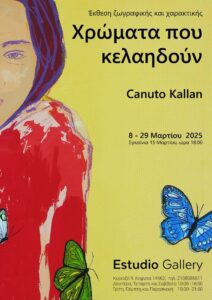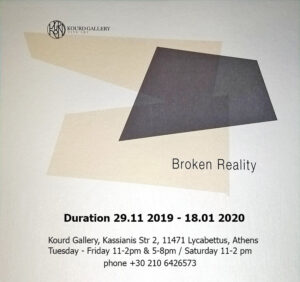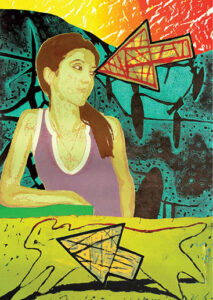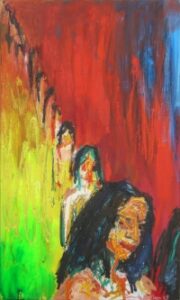
The exhibition of the Danish painter Canuto Kallan, titled “Colours That Sing”, is being presented at Estudio Gallery in Kifisia. This is a small retrospective exhibition of Kallan, featuring paintings and engravings from recent years. At the heart of the artist’s interest is always the human being in various aspects of life. Profoundly existential, he seeks, through his figures, moments of human emotion. The themes that concern him are related to the essence of pivotal encounters. For example, in the painting “Refugees”, we are confronted with four female figures. Kallan calls them Sophia, Faith, Love, and Hope. Naturally, they relate to the human condition within an abstract landscape. They cling to one another, symbolising the human need for solidarity and connection—bonds that, in difficult moments, will keep the human subject standing.Canuto Kallan’s colours play a catalytic role in the intensity of each painting. He believes that life, even in its most difficult moments, is full of colours. His figures are often dressed in vibrant yellows, greens, and reds that contrast with the sadness or disappointment they may carry. In the painting “Nostalgia” we see a woman in an intense deep red reminiscing about a figure from the past. We understand it is the past because her gaze is turned backwards. Kallan here refers to humanity’s need to recognise its past. The nostalgia of a love affair has, of course, the red colour of the woman’s clothes.
Human-centred, the painter with a strong female presence in his paintings, completely disregards outlines. He is interested in the form as a whole. His faces are almost spectral, multicoloured shadows that move or stand in space. He observes human behaviour and captures it on canvas with the strongest colours. Colours that stay in your memory and soul. It is impossible to see a Kallan painting and not be deeply impressed by the chromatic intensity of his painting. In the painting “Before the Match”, we encounter five male figures with hats, almost masqueraders preparing to “celebrate” an enigmatic contest that reveals no emotions on their faces, but masks – personas that hide each one’s story. With a hat and a scarf, we can all become fanatical, forgetting or carrying our pain or personal joy.
Amidst the crisis of values we are experiencing, Kallan manages to deal with people, their anxieties, sorrows, joys and the surrounding atmosphere. He uses colours to exorcise a deep lack of satisfaction, a hidden wound. His blue is characteristic, almost otherworldly, of a society in deep decay. His landscapes are abstract; he captures shapes and volumes on canvas, without focusing on detail, but always on the sense of things. In the silkscreen “Monastery of Panagia Hozoviotissa” Kallan sees the monastery emerging from the rock, almost hovering between heaven and earth with its brilliant white colour. Thus rendering the element of sacredness and the worshipful character of the place.
It is an exhibition about humans and the colours that flood us at every moment of our lives, in all our aspects. Colours, anyway, have been singing about the joys and sorrows of people since the beginning of the world, but artists with aesthetic criteria capture them. Canuto Kallan is full of colours and love for art, but primarily for the human being.
Polina Gourdea

The Printmaking Artwork as a Reflection of the Society
The crisis shatters our equilibrium. It fractures the image we have of ourselves and of the Other, the Foreigner that we fear. Because he exists deep inside our own Being. Because he exposes, in the words of psychoanalyst Julia Kristeva, “our disturbing otherness, for that indeed is what bursts into contront that demon, that threat, that apprehension generated by the projective apparition of the other at the heart of what we persist in maintaining as a proper solid ‘us.”
The crisis constitutes the heterotopia wherein the rifts with the social and cultural status quo occurred at the turn of the 20th century, during the interwar years and following the end of the Second World War. Ground-breaking movements were born at that time, which shaped an art landscape unburdened by the faithful depiction of nature and man, unrestricted by the guidelines of the famed commission agent, open to unlimited experimentation at the hands of its creators, and accessible to a larger audience: expressionism, cubism and surrealism, abstraction, art brute, pop art, minimalism and later on arte povera, graffiti. These are the starting points for the dialogue that takes place between the new printmakers and the acclaimed masters, painters and printmakers. (Braque, Kokoschka, Hartung, Penck, Rauschenberg, Serra, Tapies, Chillida, Tobey, Vostell) from the collection of the Austrian artist and participant in this exhibition Joachim Lothar Gartner.
Varying techniques meet varied materials, and so these artists demonstrate the continuation of the mag cal art of printmaking, although still largely underappreciated in our country. Mapping out through their work its evolution from its outset – with the prehistoric rock paintings – throughout the renaissance and the modernism and coming up on the present
Moving within the stark lines of Fritz Lang’s expressionist cinema and the New Objectivity, and driven by the dreamlike power of surrealism, they etch into metal and cut on wooden matrices the mass-produced anthropomorphous creatures with the otherworldly masks and diving helmets, that are built with the help of robotics to replace humans in today’s workforce.
They pick pieces out of advertisements and out of the graffiti on public walls, enlarge and lay them atop even and painted with bold strokes female visages, creating thus a genuine folk art that follows in the footsteps of the COBRA movement.
They carve into the wood silhouettes that sway to the rhythms of nature and remind us, with their lean and slender forms of the frescoes of Minoan Crete. They print them then onto thin sheets of paper and use the film-editing techniques of the Russian avant-garde and the French new wave to piece them together into one whole
They trace abstract figures with the fluid lines of expressionist Francis Bacon, and with his distorted and silenced faces that are cut off from the rest of the body with a white parallelogram. They pen with acid our most intricate drives, and depict them as a mirror that’s been shattered, cracks radiating from its centre, where we find ourselves suspended, or as a wave of colourful streaks that shoots of into the distance, toward an imagined ext out of the straw fields of Anselm Kiefer, and enthrals us They weave, as grandmothers do, our everyday life in between multicoloured rectangular and vertical lines, using the abstract technique of pattern, and then let it fade away inside black-and-white honeycomb cells, much like our dreams do.
They lean on their knowledge of the history of art and on the human experience to create shapes and forms out of the past and the present, and so they piece together the fragmented reality that has always made up our Being.
Lida Kazantzaki
art historian

Similarity in Diversity
I am convinced that, by and large, in the arts, exploration and ongoing learning, the endeavour to expand our knowledge and our capabilities, never do stop. Throughout life the aim is to search and find truths and express them, each in his own personal way.
In the present exhibition, five artists who are on such a course in the field of printing, specifically silk-screen printing, present their most recent work. Although the visual approach of each reveals the difference of personality, there is something common in the works presented: the free gesture by means of which the artist manages his subjects and makes his statements. The immediacy made available by silk-screen printing techniques helps to make visible the cleanness of the writing and the execution. Sometimes even a random element that occurs is integral to the whole and has a part to play. In these works, the participants’ mastery of their expressive means is evident, along with the well-assimilated sense of design, form and composition.
Four of the artists, Michail Adamis, Canuto Κallan, Dimitris Spanopoulos and Michael Falconis, after graduating in painting from the Athens School of Fine Arts, took on a second degree in printing, which was effectively a postgraduate course of study. The knowledge and experience from the study of painting played a decisive role in their exploration. It is noteworthy that they had the maturity to comprehend immediately the language of silk-screen printing and to avail themselves of its rich expressive means (layered prints in different colours, photo transfer of images, enlargement of printing size etc.). The outcome was to attain sufficient mastery so they could use silk-screen printing exclusively for their dissertation.
The fifth artist, Michael Ward, with studies in England in printing and painting, in his prints, makes expert use of textures and qualities on which he juxtaposes non-representational shapes, as powerful as symbols. His works possess daring and variety and can elicit in the viewer unexpected responses. The element of experimentation in the exploration of the monotype is present.
Akis Peirounidis, Assistant Professor ASFA

An Other Reality
Canvas representations are usually the personal narrative of their creator. Many times, this narrative seems strange and meaningless, at the same time dreamy and nightmarish. The distortion of the forms aims at a revelation: Things come to light and embrace the human relationships of the time of each artist. The emerging forms belong to another world, symbolic and at the same time present. In this world, we are called to travel through the context of the works of Canuto Kallan. On the occasion of his solo exhibition at the Polichoro Metaixmio from March 2012, visitors have the opportunity to see the compositions of the artist who is clearly influenced by the Co.Br.A movement, Expressionism and by painters such as Emil Nolde and Marc Chagall.
Intense colours, movement and depiction of anthropocentric situations are the components of Canuto Kallan’s art. He argues that without colour there can be no, something that becomes apparent at first glance one will see in his works. Figures that stumble, stand, look, reminisce, fall in love and most importantly, live within the dimensions of a painting or a silkscreen. Canuto Kallan is one of the masters of the use of colour, due to the vital importance of this element in his compositions. His figures travel in colourful universes, which are as hard as today’s reality. The artist comments on reality having as his weapon the emergence of forms, the relations with nature, society and ourselves.
Beauty, ugliness, vagueness and complete composition of the contours, in short, a multiplicity of forms in terms of their being. This I think is the key element that makes Canuto Kallan’s art so interesting. The light and the darkness, which result from his works, declare that the darkness of the soul has as its spell the colour. The thirst for living forms, dreamy or not, is the demand for art that provokes our gaze. An exhibition worth visiting since our time needs colour transfusion in all its forms. This explosion of colours leads us, perhaps unconsciously, in a direction of externalization. It also achieves this by choosing the forms that emerge autonomously from the canvases, well-structured and peculiar in terms of their composition, thus confirming their detailed processing. The way the art of Canuto Kallan provokes our eye is, in essence, our need for externalization. The battle is between the escape of the figures and their stay in the narrow frames of the canvas or paper. Taken as a whole, the compositions give the feeling of an inner request for freedom, they awaken in the viewer the desire to search. The space of the compositions, almost always undefined, with a colour that floods everything, reminds us of the fluidity of the subjective narrative. The darkness of Canuto Kallan has colour and thus speaks of the unconscious depths, illuminating the harsh reality with dazzling colours, without losing the human dimension and moderation. So reference to another reality that we all need!
Polina Gourdea

With strong influences from the Cobra movement, Situationism and Expressionism, Canuto Kallan’s art express nostalgia for the return to the primal instincts, the liberation from the constraints of reason and the importance of the very act of painting. His works stress the subjective emotion over the objective reality and give priority to the way the latter is represented, adopting complete freedom in the choice of the colours, the simple forms, the feverish brushwork, the dynamic contrast of the colours and the contrast between the shapes and the chromatically flat surfaces that constitute the background plane.
Kallan’s figures often convey strong messages of demonstration and social criticism and bring the viewer face to face with the harsh side of contemporary human existence, the unbalanced, violent relation of humans with society, nature and themselves. The distortion of the shapes aims at revealing the essence of the matters and brings to light the corruption which prevails in today’s human relations.
Whether seen as a whole or separately, Kallan’s multi-figural compositions create comparisons and cohesion and obtain a narrative quality, but they also constitute autonomous creations with multiple “readings”. Allegories and metaphors fuse with emotions that range from jubilation to anguish, transforming the painter’s and the viewers’ personal experience into a universal possession.
V. Vagenou, Art Historian

Canuto Kallan by Lida Kazantzakis, art historian
Canuto Kallan was born in Copenhagen, Denmark in 1960. He specialized in the art of wood-crafting at the Technical College of Copenhagen and graduated from the Technical University of Denmark with a Master of Science in Engineering. In 1993 he moved to Greece and studied painting at the Athens School of Fine Arts (ASFA) (1997-2003) with Yannis Psychopaidis and Marios Spiliopoulos as his professors. Since 2004 he also studied engraving/ printmaking with Vasilis Kazakos and Michalis Arfaras.
To date, he has made two solo exhibitions at :
-the Art Society of Royal Library “Black Diamond” in Copenhagen (2002)
-the art gallery “To Milo” in Athens (2005).
He also participated in many group exhibitions, such as:
-the exhibition of “Livres d’artistes” of the workshop of Graphic Arts, Typography and Art of Book of ASFA, in gallery “7” in Athens (2001/2002),
-the exhibition “South-eastern Europe North. Aller Retour”, in the gallery “Krebsen” of Copenhagen (2003),
-“Graduates 2002/3”, in the “Factory” of ASFA (2004),
-Engravings exhibition in the gallery Eirmos in Thessalonica (2005),
-IV Biennale, the artmagasin “Ta Nea tis Technis” and the hotel Creta Maris, in Crete (2006),
-“Nuit Blanche in Toronto”, the Greek consulate Toronto (2007).
The paintings of Canuto Kallan are, without doubt, an integrated part of the long tradition of modernism, but they also reflect the environment in which he lives, in terms of place and time. Kallan’s landscapes rendered with fragmented surfaces and complementary sharp colours reveal his studies on Cezanne and the Cubists’ analytical idiom, as well as mainly on Expressionism, and at the same time exhibit a tender lyricism through their rhythm. Landscapes painted with the aggressive brushstrokes of the “Neue Wilden”, commenting on reality with a subtle irony. Characteristic is the painting “11 September”, where the aeroplane that had caused destruction is depicted, small and grey as a toy, in contrast to the enormous colourful horizontal bands and curves of the Twin Towers.
Unique is also the “video wall”, which severely criticises the virtual reality of our times. A male figure coloured in warm tints of brown and red, holding a black walking stick and wearing a big green hat, returns us into the past. His posture has a balancing effect on the untamed colour and expresses a person focused in the core of his calm motionlessness. This is what differentiates him from the three contemporary pictures, that compose the “wall” opposite to him. An inexpressive male figure, coloured with glaring tints of green and the two female figures, one with a skateboard, and the other one nude. The extreme bending of the first woman’s body, as well as the extreme opening of the second woman’s legs, reflect the danger associated with the blistering speed and the exploitation of human beings by the principles of the market.
In the end, I would like to refer to his “Rhapsodies” that, in my opinion, highly represent the gist of his artistic creation. Their style reminds us of the political “Crosswords” of his professor Yannis Psychopaidis. In contrast, they are mainly made of small – dimension people, moulded plastic or levels, that intensify by way of thick clean brushstrokes and their angular outlines, the (projected feelings) sentiments that are expressed.
Covered partly by gauze or by a white coating, that lets only the eyes or the mouth speak. Distorted as a caricature, expressing not only the genuine grief of man but also his agony for being trapped into solitude, a subject of our times. Faces that demonstrate through the tenderness of the plain chromatic volumes and the expressions of affection and passion that unit them, the force of genuine communication. “Rhapsodies” of the polymorphism of human expression. The artwork of Canuto Kallan on canvas, paper or the silk-screen, with oil or oil pastel, connects the north with the south. It uses the vocabulary of expressionists of the north, of Edward Munch, Emil Nolde, Asger Jorn. Kallan attempts, like the politically focused Jorn, co-founder of some of the most important movements of the 20th century, like the “Fantastic Bauhaus”, the COBRA or Situationism to ground his art in life, having at the same time released it from the dark, demonic mysticism of the north.
The colour that Kallan handles dynamically: gestural expression soaked by the fierce light of the Mediterranean and the gentleness of the idiosyncrasy of its world. It infiltrates into the unconscious depths of human existence and illuminates hard reality without passion as well as without destroying the human tinge and measure.
Lida Kazantzakis, art historian

The Man who became a Painting by Marios Spiliopoulos, Painter, Deputy Professor of the Athens School of Fine Arts
“I first met Canuto Kallan 8 years ago, in 1997, a freshman at the Athens School of Arts. He was a colourful tall and thin figure wearing a colourful pullover with stripes. Every stripe had a different lively colour exhausting the colours of the spectrum. The collar of his shirt, popping up, was of cadmium yellow. His jeans were carmine red and his backpack (rack sac), leaning by his shoulder, emerald green. This colourful patchwork of his outfit was complemented by golden, round spectacles, blushing cheeks, and fair hair. He was shy and with an alien accent. Danish, with a Greek origin, as he told me, who loved painting. I noted that he looked as having fled from a Hundertwasser painting and that I hoped what he drew had the same harmony and colour intensity as his clothes.
With Canuto, we sea-waved together, during his schooling, up to his graduation. I eye-witnessed the whole of his course of exploration. He was and still is, extremely diligent. Colour at first was vague and grey, his sketches pure expressionistic. Our conversations followed a certain motif: “Can’t you see how colourful your outfit is?” He always replied calm and confident “I’m trying”.
He was, and is, very concerned with the human figure and strived with it without rest. He was, and is, a vivid (descriptive, expressive) painter.
As time went by, I witnessed his transformation. I saw Canuto, himself, sliding into his paintings, day-by-day. His dressing manners became gradually elusive in dimensions work, with oil on canvas. His colour cleared, became bright, almost brash, most of the times straight from the tube. Stains and clear lines, gestures of intense colours outline the vivid parts of the work and contradict the monochromatic surfaces of the font. The painting work in Canuto is conduced, not in his mind a priori, but on the canvas itself. It is there where the bet is placed and there where it is won or lost. All his agony takes form on the canvas and the sorcery of the colour navigates it. The clear, saturated colours are the vessel, which voyages him into the relish of painting.
At first sight, his painting has the carefree, unconcerned joy and surprise of naive painting. However, the viewer, upon insisting on this joyful feeling of this banquet of colours, discovers that the portrayed is at one time a tragic part of life and at another a hard incident of everyday reality.
Canuto’s works project primarily painting – as an act of redemption – and gradually their theme lands you, often churlishly, to remorse reality. Especially his work “The Accident” or “The Metamorphosis” (80X70 cm) has an oblique synthesis. On the bottom left edge crowd paints, stains, lines, intense gestures with clear colours-like cadmium or vermillion red, citron or cadmium yellow, cerulean blue and purple-which subject to the viewer a car accident.
The font is defined by a broad line of cadmium red, running diagonally the whole surface of the canvas, which is cobalt blue. We can also observe two formed figures, green emerald, crossing the red limit and escaping towards a stairway at the top-right edge of the canvas. Might these figures be fleeing towards a celestial world, like the human souls, or are they just vanishing (perishing) in the world of cobalt blue after crossing the red line?
I’m trying here to explain how Canuto became a painting himself and found an accurate and purely personal way to express his agony for the social and the human. Simply and smoothly he found his pace in the tracks of colour. And now, I believe he can depart in full sail for his voyage in the ocean of art. Moreover, I always believed that during our post-modern period “the strictly subjective is universal and global” thus alive and contemporary.
Canuto, farewell and don’t forget us wherever you go.
Marios Spiliopoulos
Painter
Deputy Professor of the Athens School of Fine Arts”
